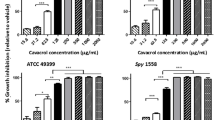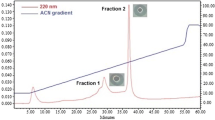Abstract
Recent studies have shown that some serine protease family members may play an important role in antibacterial activity. Chymotrypsin, a major member of the serine protease family, was used in our study to investigate whether it has a similar function. Optical absorbance, broth microdilution and scanning electron microscopy (SEM) assays were carried out to investigate the direct effect of chymotrypsin on bacteria. A disk diffusion test and LC-MS spectrometry were then used to investigate the effect of chymotrypsin on antibacterial activity of ampicillin. Chymotrypsin exhibited potentially antimicrobial properties to two kinds of Gram-positive bacteria (Staphylococcus aureus and Enterococcus faecalis). However, the existence of chymotrypsin could also hinder the antibacterial activity of ampicillin, in part because chymotrypsin could degrade ampicillin in a dose-dependent manner. These results could be helpful in guiding current commercial usages of chymotrypsin and devising better strategies of clinical applications.






Similar content being viewed by others
References
Gao K, Zhang S (2009) Ovochymase in amphioxus Branchiostoma belcheri is an ovary-specific trypsin-like serine protease with an antibacterial activity. Dev Comp Immunol 33:1219–1228
Granelli K, Branzell C (2007) Rapid multi-residue screening of antibiotics in muscle and kidney by liquid chromatography-electrospray ionization-tandem mass spectrometry. Anal Chim Acta 586:289–295
Guell I, Micalo L, Cano L, Badosa E, Ferre R, Montesinos E, Bardaji E, Feliu L, Planas M (2012) Peptidotriazoles with antimicrobial activity against bacterial and fungal plant pathogens. Peptides 33:9–17
Hessle CC, Andersson B, Wold AE (2005) Gram-positive and Gram-negative bacteria elicit different patterns of pro-inflammatory cytokines in human monocytes. Cytokine 30:311–318
Imbach P, Lang M, Garcia-Echeverria C, Guagnano V, Noorani M, Roesel J, Bitsch F, Rihs G, Furet P (2007) Novel beta-lactam derivatives: potent and selective inhibitors of the chymotrypsin-like activity of the human 20 S proteasome. Bioorg Med Chem Lett 17:358–362
Jukes TH (1972) Antibiotics in animal feeds and animal production. Bioscience 22:526–534
Kanke T, Takizawa T, Kabeya M, Kawabata A (2005) Physiology and pathophysiology of proteinase-activated receptors (PARs): PAR-2 as a potential therapeutic target. J Pharmacol Sci 97:38–42
Kim JY, Park SC, Kim MH, Lim HT, Park Y, Hahm KS (2005) Antimicrobial activity studies on a trypsin-chymotrypsin protease inhibitor obtained from potato. Biochem Biophys Res Commun 330:921–927
Kraeva LN, Pozdnev VF, Kokriakov VN, Usova AA (1991) Determination of the esterase activity of serine proteinases using synthetic substrates. Lab Delo 1991:22–23
Lefevre J, Delepelaire P, Delepierre M, Izadi-Pruneyre N (2008) Modulation by substrates of the interaction between the HasR outer membrane receptor and its specific TonB-like protein, HasB. J Mol Biol 378:840–851
Meersman F, Dirix C, Shipovskov S, Klyachko NL, Heremans K (2005) Pressure-induced protein unfolding in the ternary system AOT-octane-water is different from that in bulk water. Langmuir 21:3599–3604
Morgan JG, Sukiennicki T, Pereira HA, Spitznagel JK, Guerra ME, Larrick JW (1991) Cloning of the cDNA for the serine protease homolog CAP37/azurocidin, a microbicidal and chemotactic protein from human granulocytes. J Immunol 147:3210–3214
Ohta T, Shimizu K, Yi S, Takamura H, Amaya K, Kitagawa H, Kayahara M, Ninomiya I, Fushida S, Fujimura T, Nishimura G, Miwa K (2003) Protease-activated receptor-2 expression and the role of trypsin in cell proliferation in human pancreatic cancers. Int J Oncol 23:61–66
Rezaei-Ghaleh N, Ebrahim-Habibi A, Moosavi-Movahedi AA, Nemat-Gorgani M (2007) Effect of polyamines on the structure, thermal stability and 2,2,2-trifluoroethanol-induced aggregation of alpha-chymotrypsin. Int J Biol Macromol 41:597–604
Tsuji Y, Nakajima Y, Homma K, Natori S (1998) Antibacterial activity of a novel 26-kDa serine protease in the yellow body of Sarcophaga peregrina (flesh fly) pupae. FEBS Lett 425:131–133
Woloshuk CP, Meulenhoff JS, Sela-Buurlage M, van den Elzen PJ, Cornelissen BJ (1991) Pathogen-induced proteins with inhibitory activity toward Phytophthora infestans. Plant Cell 3:619–628
Acknowledgements
This work was supported by Nanjing Medical University Science and Technology Development Fund 06NMUZ005 and in part by the Priority Academic Development Program of Jiangsu Higher Education Institutions.
Author information
Authors and Affiliations
Corresponding authors
Rights and permissions
About this article
Cite this article
Zhou, D., Liu, Z., Zhang, D. et al. Chymotrypsin both directly modulates bacterial growth and asserts ampicillin degradation-mediated protective effect on bacteria. Ann Microbiol 63, 623–631 (2013). https://doi.org/10.1007/s13213-012-0512-x
Received:
Accepted:
Published:
Issue Date:
DOI: https://doi.org/10.1007/s13213-012-0512-x




